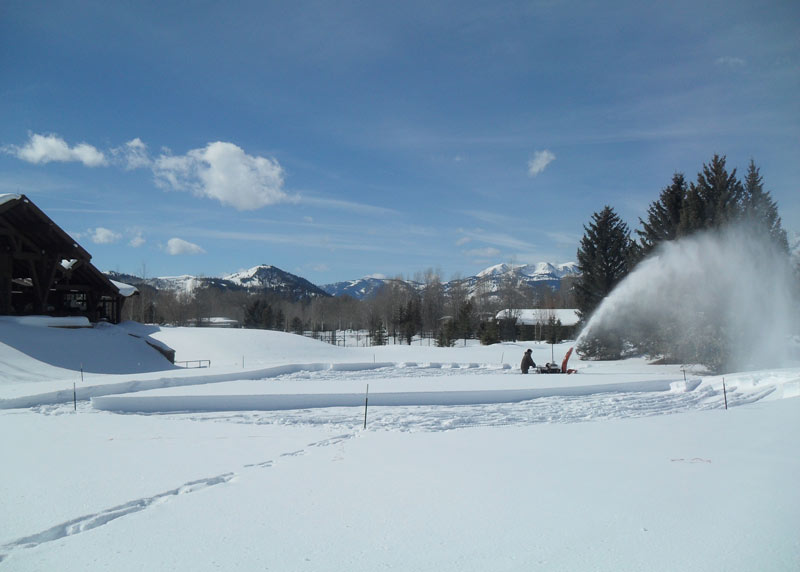
Spring snow removal at Jackson Hole Golf & Tennis Club in Jackson, Wyo. The site typically has 2 to 4 feet of snow at winter’s end. Photo courtesy of Jackson Hole Golf & Tennis Club
Just as superintendents in Florida may struggle with keeping gators out of ponds, working in the shadow of the Teton Range comes with its own unique set of challenges, among them temperatures that plunge well into the negative double digits, and mountain wildlife that gobble up the greenery. For three superintendents in Jackson, Wyo. — Dan Tolson, CGCS, from The Club at 3 Creek; Mike Kitchen, CGCS, from Teton Pines; and Andy Erskine from Jackson Hole Golf & Tennis Club — battling such extreme conditions to keep their greens and fairways shining bright is all in a day’s work.
Though only a few miles apart, the three golf facilities face different obstacles because of varying microclimates. However, the local course managers stay in frequent touch and are always eager to help each other out. “All the superintendents in the valley are a pretty close-knit group,” says Tolson, a 15-year GCSAA member. “That’s a lot of our success through the year — that we can count on each other when needed.”
Such assistance extends to borrowing equipment and sharing course-monitoring observations. “If I call Mike and he has snow mold on March 3, I know I’ll have snow mold the week after, or vice versa,” Tolson says. “We just work together to help each other. The industry as a whole is like that, but especially here, because we’re so isolated.”
Tolson is used to the camaraderie, having grown up in the golf business. His father was a superintendent. Tolson spent his summers working on courses, caddied in high school, majored in turf science at Colorado State University, and worked at several golf courses before becoming the superintendent at The Club at 3 Creek in 2007.
Kitchen has experience at a variety of western mountain courses, from Coeur d’Alene, Idaho, to Colorado to the Tetons. He has been superintendent at Teton Pines for 14 years.
After a career in the finance sector, Erskine wanted a change, so he headed back to school in South Carolina, earning a degree in agricultural sciences with an emphasis on golf course management. He later became the superintendent at Jackson Hole Golf & Tennis Club.
Baby, it’s cold outside
All of their experience comes in handy in an area where the lowest recorded temperature — in nearby Grand Teton National Park — was -63 F. The town of Jackson has recorded a record low of -50 F, and every year brings temperatures well into the negative double digits, with January being the coldest month. Approximately 320 days a year have frost potential.
With temperatures so low, the ground can freeze up to 5 feet deep in winter, creating challenges in a field where soil temperature is key. Even when the weather is pleasant in spring and early summer, the soil temperature remains cool well into the summer.
“We don’t have a strong biological cycle until the Fourth of July,” Tolson says.
Later in the summer, the ground quickly cools, lowering the grass’s recuperative potential, as cart compaction and other factors cause difficulties.

Although snow insulates the greens at Teton Pines from certain problems, it also masks other issues that may be developing underneath. Photo courtesy of Teton Pines
Working toward winter is a constant given the short season.
“Just when you get the golf course where you want it, you start beating it up again to prepare for winter,” Kitchen says, referring to aerification and other intensive practices.
Jackson-area superintendents have to get creative to balance maintenance needs with maximum playing potential, as the courses generally do not close for extensive maintenance work during the short season.
“A lot of the work we need to do to keep the grass healthy has to be done in a short season when the golfers also want to be out there using it,” Tolson says. “We’re trying to balance getting out there and working and keeping it healthy but keeping it playable and staying out of golfers’ way.”
Sometimes that balance means getting to work well before the sun rises. “You have to be creative in your approach and how you aerify, fertilize and topdress,” says Kitchen, a 22-year GCSAA member. “Sometimes you have to be here at 3 a.m. for a jump-start.”
With such fleeting golf seasons, winter is always on the minds of Jackson superintendents — even on a sunny, 85-degree summer day. “Almost every agronomic decision I make has to start with the question, ‘How will this impact us going into and coming out of winter?’” says Erskine, a nine-year GCSAA member.
The winter of 2013-2014 was a tough one in the Jackson area, as snow cover was light early on and was paired with bitterly cold temperatures. Then, rain created an ice layer, and a month of heavy snow followed. “It was go-go-go since February, blowing snow, chopping ice, aerifying, covering,” Kitchen says, as keeping greens alive through winter is key. “To me, the challenge of this area is that it isn’t a terribly difficult place to maintain grass if it makes it through the winter,” Kitchen says. “But if it doesn’t, by Fourth of July, you use every tool. It’s a challenge to survive winter, and if you don’t, it’s crazy.”
Ready for the deep freeze
Resuscitating dead turf is a time-intensive and difficult job, so course managers focus their attention on being proactive to keep turf alive throughout winter.
“Winterizing the course properly will save a lot of sleepless nights during the winter months,” says Erskine, whose winter prep at Jackson Hole Golf & Tennis Club includes making sure his irrigation system is ready for the deep freeze. With miles of pipe and 3,000 irrigation heads, this component needs a lot of attention.
“Blowing out our irrigation system is crucial due to the fact the ground can freeze up to 4 or 5 feet deep during our long winters,” he says. “This is one of the more stressful processes we undergo, and there is always some anxiety in the spring when we charge the system and really find out how good of a job we did the prior fall.”
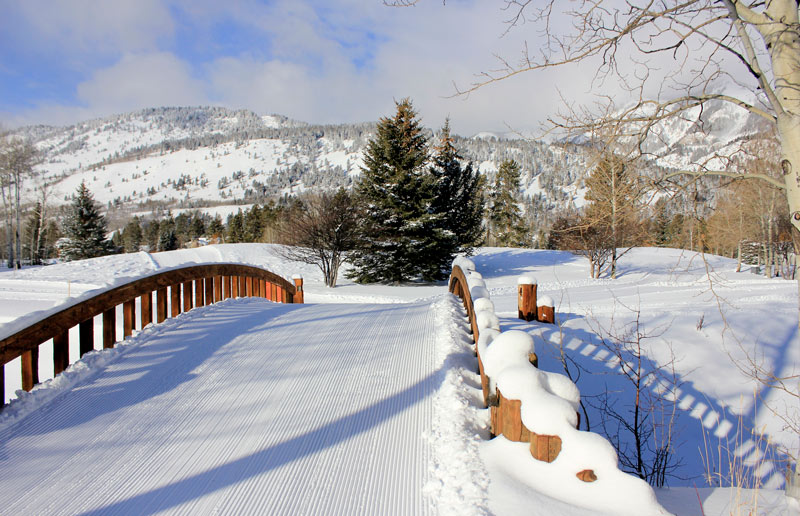
Keeping Teton Pines groomed for winter recreation activities keeps the grounds crew busy — even when the temperature drops well below zero. Photo courtesy of Teton Pines
When the season gets cold and snow flies, the courses switch gears to focus on winter maintenance and winter recreation activities, including plowing, grooming ski trails and preparing ice-skating ponds.
And there’s a lot of snow. At an elevation of 6,300 feet, Jackson is a prime skiing destination, and nearby Jackson Hole Mountain Resort received over 40 feet of snow last winter. Teton Pines, just down the road from the ski mountain, receives approximately 25 feet of snow each winter. Other courses receive less, though Teton Pines’ Shooting Star course, right at the base of the ski hill, receives far more.
Snow serves as an effective insulator, protecting the course from the cold. Jackson Hole Golf & Tennis Club typically has 2 to 4 feet of snow by the end of winter, providing a nice blanket for the turf. Low-snow years can be problematic.
“Exposed turf can become desiccated and die due to extreme cold and windy conditions, which will suck all the moisture out of the plant, even when dormant,” Erskine says.
However, while the snow insulates, it also obscures. “The hardest part of snow cover is not knowing exactly what is happening underneath,” Erskine says. He digs pits on the greens to examine the subsurface microclimate. He and his crews also blow snow off the greens two or three weeks before the spring “melt-off” to curtail potential damage from freeze-thaw cycles.
When snow melts, particularly in midwinter, it pools beneath the surface, refreezing when temperatures plunge again. “It essentially suffocates the turf where it can’t breathe,” Tolson says. “Gas fills up and it’s toxic to the grass.”
Snow mold is another foe in the region. Given that the fungus thrives in dark, cold, wet environments and under prolonged snow cover (more than 90 days), Jackson is a prime spot for outbreaks. Preventive sprays are used, and managers have various techniques for dealing with outbreaks, including cutting out and resodding dead patches and overseeding dead spots in the hope of returning them to their former glory.
Summertime stress
Even the summertime weather in the mountainous region can cause problems. “We have microbursts out here all the time,” Kitchen says. “We have our chain saws ready to go.” From time to time, lightning strikes also damage Tetons Pines’ sprinkler system, which is wired into an electrical grid of copper.
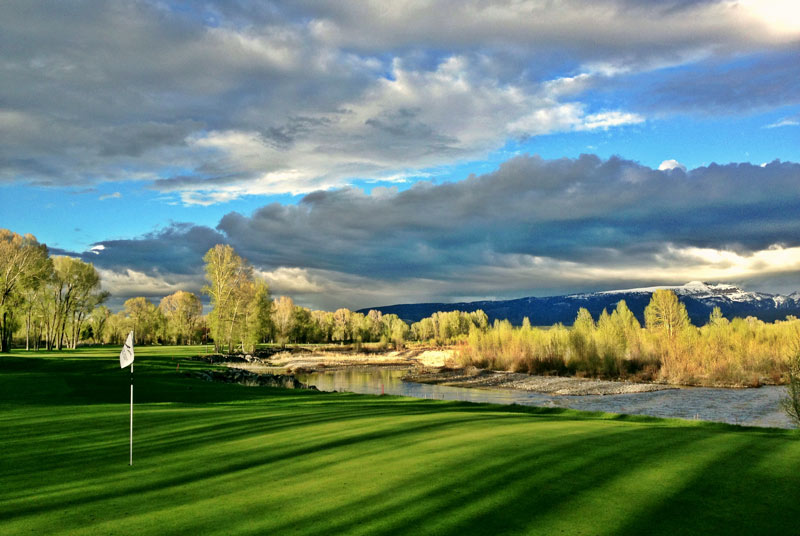
The maintenance crew at Jackson Hole Golf & Tennis Club must remain vigilant in steeling the turf against winter’s fury, even during ideal summer conditions. Photo courtesy of Jackson Hole Golf & Tennis Club
While precipitation can make life a challenge, superintendents in such a pristine location also concern themselves with wastewater and runoff.
“Jackson Hole is a pretty important area ecologically and environmentally, and managing a golf course in the midst of that is a pretty important responsibility that I take seriously,” Tolson says. “In my opinion, golf courses are adding to and contributing to wildlife of the area, but it also means we can’t go out and liberally use fertilizers and herbicides. We have to be pretty careful.”
During the construction of The Club at 3 Creek, drainage systems were installed to filter the water before its release into ponds or groundwater. Extensive monthly testing is conducted at multiple sites to ensure the water leaving the property is of the highest possible quality. The water on The Club at 3 Creek feeds into Spring Creek, a tributary of the Snake River that serves as a spawning area for cutthroat trout.
Where the wild things are
When the climate isn’t causing concerns, the wildlife often is. As part of the Greater Yellowstone Ecosystem — one of the largest intact ecosystems in North America — Jackson sees consistent activity from resident wildlife.
At The Club at 3 Creek, elk are the primary concern, as 1,300 head live very close year-round, taking a brief hiatus to go to a feeding ground south of town for two months each winter. “They live here and love nothing more than to come on our golf course and eat our fairways,” Tolson says. “It doesn’t take a lot of elk to do a lot of damage. It takes a lot of man-hours to fix.”
The course has night security that maintains a presence, encouraging elk to stick to their native forage. “It’s not foolproof,” Tolson says, citing a recent night when 30 elk caused considerable damage to a hole. “They weigh 900 pounds and leave a pretty good-sized footprint that requires repair. Putting through elk tracks is not much fun.”
The animals’ waste also creates maintenance hurdles. “They urinate on the grass, and that will kill the turf pretty handily,” Tolson says. “If you’ve got 100 elk on a fairway and they urinate two times apiece during the night, that’s 200 areas the size of a basketball of dead grass that you have to take care of.” Moose also winter at The Club at 3 Creek course, browsing on willows and dogwoods and eating them down to the level of the snow.
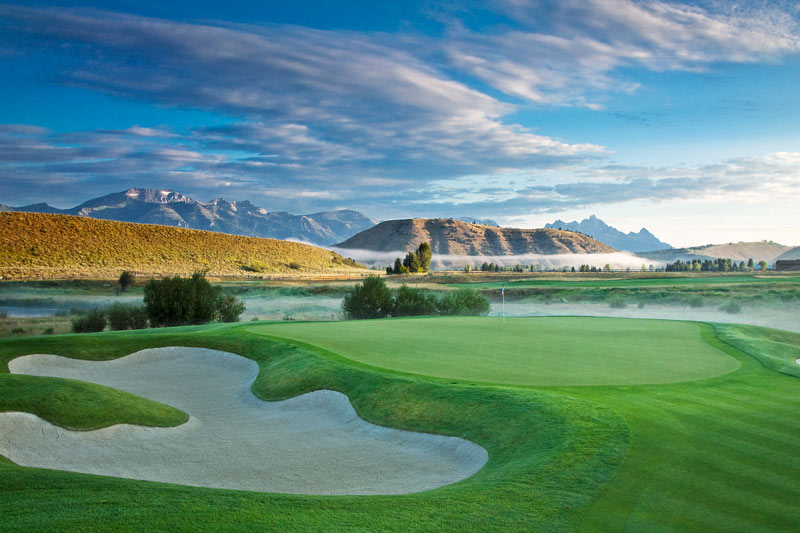
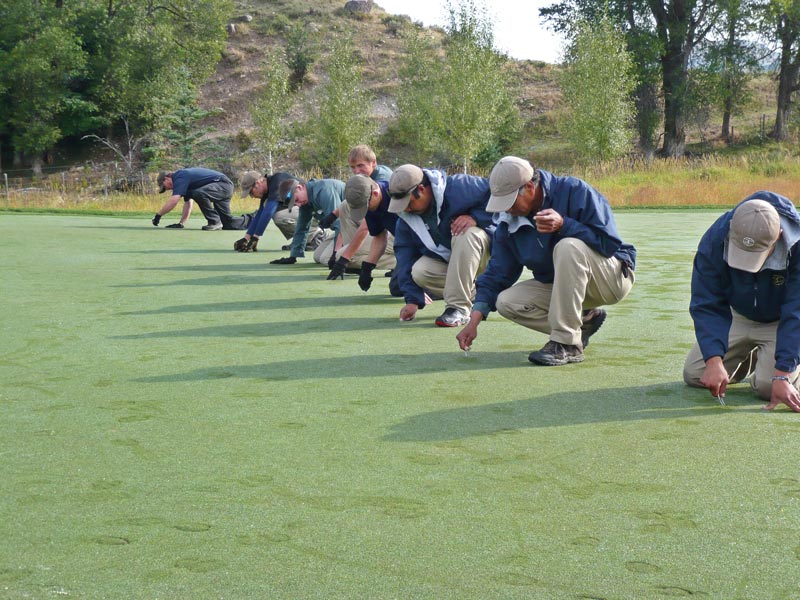
The “elk damage brigade” repairs a green at The Club at 3 Creek. Photos courtesy of The Club at 3 Creek
Adjacent to Grand Teton National Park, Jackson Hole Golf & Tennis Club has an elk migratory route bisecting the property, and hundreds of elk pass through twice each year. Bison live on the range year-round, and it’s also critical moose winter range. “Our mantra here in the maintenance department is, ‘Wildlife has the right of way,’ and we train our staff accordingly, as we are guests in their habitat,” Erskine says.
Along with elk, bears are occasional visitors at Teton Pines. Last spring, the grounds crew found grizzly tracks near the equipment bunker, and black bears often pass through in search of berries in fall.
Moose, however, are the principal animal at Teton Pines. “They’re out here year-round,” Kitchen says. “When we groom the cross-country trail, it’s like a moose highway. There’s a lot of vegetation and not a lot of people — it’s packed down and easy for them to walk on.”
The moose also like to destroy flagsticks, so the crews take them down each evening to avoid damage. During spring, mothers and newborn calves tend to stay in populated areas, seeking safety from predators and causing few problems on the course. But come fall, large bull moose come out for the “rut,” or mating season, when they clash and display their prowess. “That’s when we start having problems,” Kitchen says. “Last year, there were baby bulls out there sparring on my freshly seeded nursery.”
Despite all the trials and thrills of living and working among the Tetons, superintendents admit that sometimes, Mother Nature wins.
“God didn’t put golf at 6,000 feet for a reason,” Kitchen says. “Sometimes there are challenges we can’t control.”
Kristen Pope is a Jackson, Wyo.-based freelance writer and the managing editor of JHStyle Magazine.